Special Edition Daily Report October 9, 2004
_____________________________________________________________________________________
The Fort Edwards Archaeologist
Unearthing the Story of Joseph Edwards's Home and Fort
_____________________________________________________________________________________
Report on the Archaeological Excavations at Fort Edwards, home site of Joseph
Edwards and a French and Indian War frontier fort of Col. George Washington.
 This second major archaeological excavation is part of the ongoing project of The Fort Edwards Foundation of Capon Bridge, West Virginia, to preserve, protect and interpret the home site and fort site at Joseph Edwards's land grant on the banks of the Cacapon River in Hampshire County, West Virginia. This site represents both an early settler's home of the second quarter of the eighteenth century and a French and Indian War fort in Col. George Washington's chain of forts protecting the Virginia frontier. The excavation is under the direction of Dr. Stephen McBride of McBride Preservation Services of Lexington, KY. This report provided by The Foundation.
This second major archaeological excavation is part of the ongoing project of The Fort Edwards Foundation of Capon Bridge, West Virginia, to preserve, protect and interpret the home site and fort site at Joseph Edwards's land grant on the banks of the Cacapon River in Hampshire County, West Virginia. This site represents both an early settler's home of the second quarter of the eighteenth century and a French and Indian War fort in Col. George Washington's chain of forts protecting the Virginia frontier. The excavation is under the direction of Dr. Stephen McBride of McBride Preservation Services of Lexington, KY. This report provided by The Foundation.
___________________________________________________________________________________
Daily Report, October 9, 2004

The expanded crew arrived on another damp fall morning. The team was augmented by Kurt Rademaker, our Total Station survey expert and several student volunteers who came all the way from Maine.
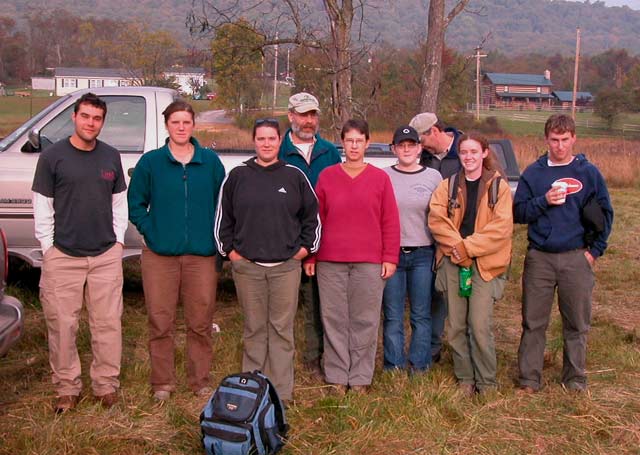
Kurt Rademaker, Ann Wilkinson, Susanne Witte, Stephen & Kim McBride, Rebecca Hartson, David McBride, Myrisa Byrd, Christopher Cox

Two shovels are faster than one, especially when there is a supervisor. The bastion feature is in the background under the white plastic. The team is expanding our area of investigation so we can see what was inside the fort wall.
|
|
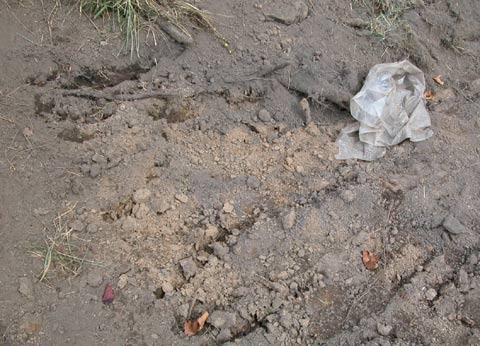
In the subdued light today and the opportunity to dry the soil opened yesterday, one can see here the signs that the archaeologist looks for when the backhoe takes off the plowzone. The gray color is the rich plowzone while the lighter brown or tan is the long undisturbed layer we are looking for.
|
|
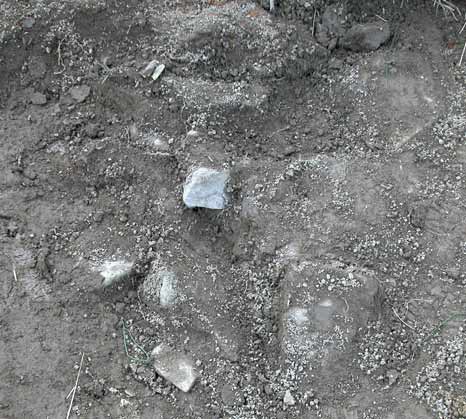
As if they are rising from the dirt, these stones are the sign that we have found the feature we think may be a cellar or fallen chimney. This is the area near the in-wall bastion we discovered in 2001. We need to find out the relationship between the stockade wall segment and these adjacent foundations. Did the stone features (cellar or chimney?) predate the stockade?
|
Mystery Features
Today brought more questions than answers. As we extended our search area in the vicinity of the in-wall bastion discovered in 2001 we discovered two puzzling features.

This feature above seems to be a wall segment running from left to right across the photo. However, it has a strange curve around what appears to be a wall segment running towards it from lower right. The top segment seems to avoid the lower segment; they do not touch.

Near the two previously mentioned features is this pair of wall segments that might connect near the stone feature just at the top edge of the photo. It appears similar to the bastion, but we do not yet know if the two lines connect. It is a puzzle.
Feature of the Day
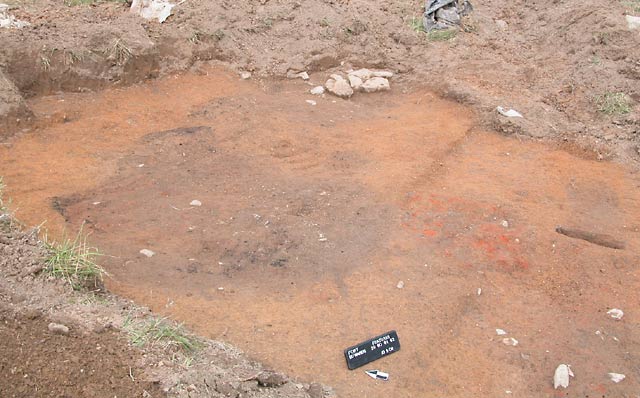
Our "Feature of the Day" is actually a group of features. We had discovered a burn area outside of the stockade wall in 2001 that we were very interested in. We know that at times too many soldiers were at the fort to all fit inside. We assumed that the burn area might be where soldiers camped outside of the fort. It could be a very good place to explore. Today that hunch proved true. The burn area turned out to be larger than previously expected. It also had a very hot area associated with it - the darker orange colored area (right center). Nearby, (top center of photo) is a pile of rocks that yielded our Artifact of the Day and other tantilizing items.
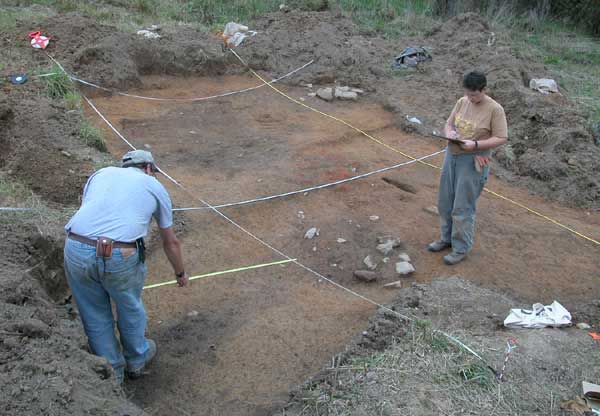
Here is another view of the burn area and stockade wall. The archaeologists are measuring it to plot its location and size.

Here we see David McBride photographing the feature. The stockade wall is the dark line in the lower right of the photo running to just above the outlined burn area at left center. We do not know the meaning of the rock pile, but it would be inside the wall; the burn area is outside. The small deep trench bisecting the wall segment is what the archaeologist uses to find out how deep the feature is without destroying too much of it. The small black board has the feature's identifying number; the small arrow points north.
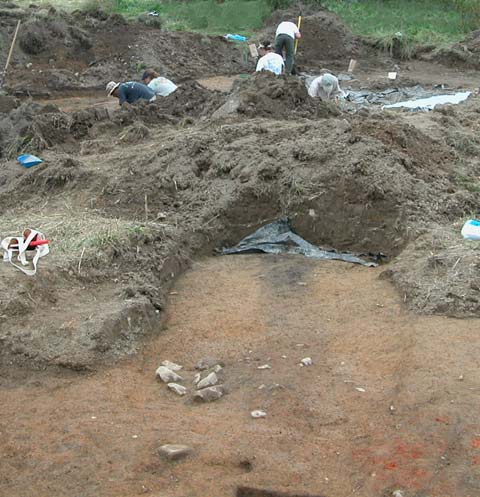
This photo is looking along the stockade wall segment that begins at bottom center. Note the red/orange burn area "outside" the wall. The bastion is under the white plastic in the upper right corner. The people are working on the two mystery features; this means the mystery features are "inside" the stockade wall with its in-wall bastion.
|
|
Artifact of the Day
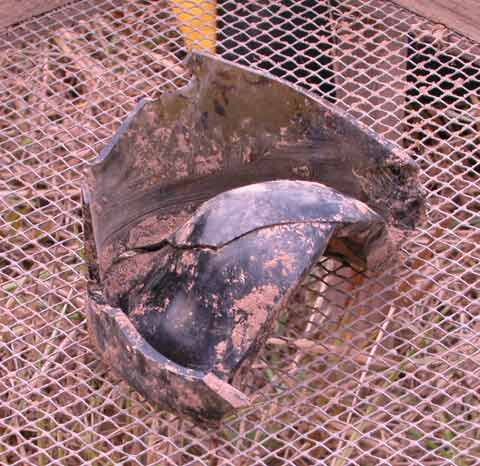
Our Artifact of the Day came from our Feature of the Day. This is the base of a wine or champagne bottle from the eighteenth century. It is one of the larger pieces of glass we have recovered. There were a few smaller pieces with it.
|
|
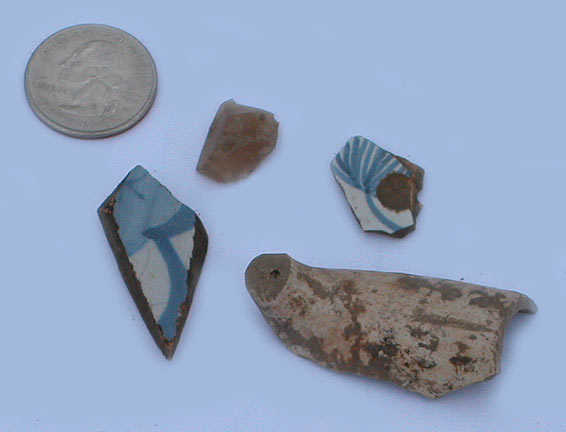
These artifacts were found near the mystery features. They include two Delft ceramic pieces (eighteenth century), a pipe bowl fragment and a piece of a french flint.
|
|
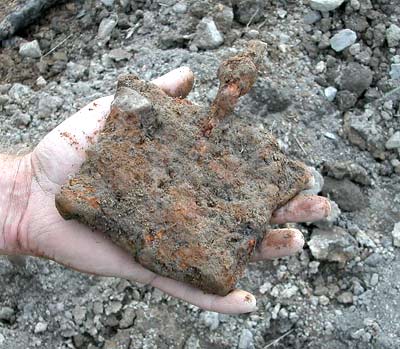
Mystery Artifact
Our Mystery Artifact today is this rectangular piece of heavy metal with what may be a handle or handle holder on it. Any guesses?
|
Meter Square Test Pit
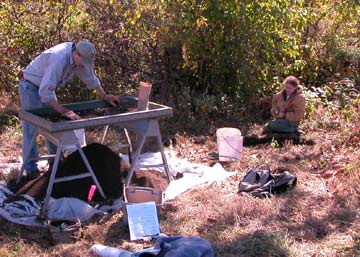 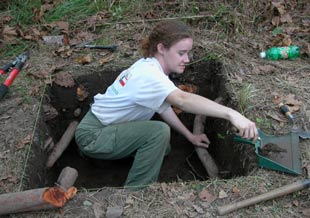
We include here a photo from yesterday and one from today. Yesterday in the bright morning sun Myrisa Byrd began a one meter square test pit. The stand nearby has a screen for sifting artifacts from the dirt Myrisa will dig. On the right is a picture of Myrisa by late afternoon today. We will check back with her tomorrow to see how deep she gets.
|
|
|















